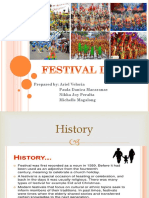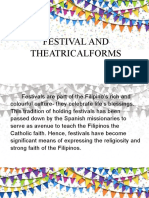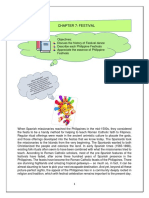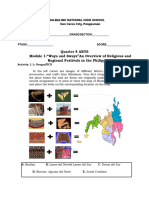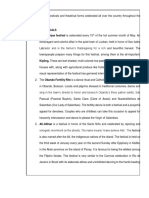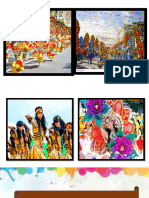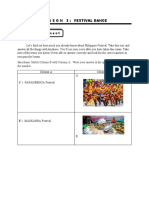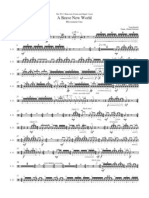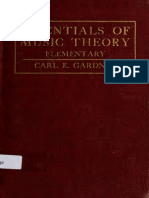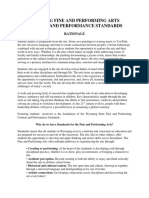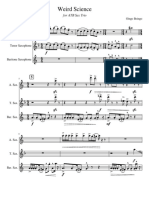Introduction to Modern Dance and Contemporary Dance
Modern dance
Modern dance originated in Europe and America in the late 19th and early 20th centuries. It was seen
as combining the physical and emotional, to express the human spirit.
From the late 1930s some modern dance practices were brought to New Zealand and taught to New
Zealanders by Europeans.
It is the rebellion against ballet that has an emphasis on effort of dance and natural body movements
that began in the late 1800s/early 1900s. Unlike the ballet with sophisticated foot ware modern dance
technique requires:
Barefoot
Uses mobility of spine
Initiate movement from core
Uses levels, including floor
Contemporary Dance
Contemporary dance began at the start of the 20th century when US dancer Isadora Duncan (1878–1927)
broke away from ballet and developed her own, more natural style. Contemporary dance has many different
styles, some of them closely linked to music, such as jazz, rock and roll, and hip-hop.
Notable Figures and Personalities In The Development of Modern Dance and Contemporary Dance
Martha Graham
Martha Graham was an American modern dancer and choreographer. Her style, the Graham technique,
reshaped American dance and is still taught worldwide. Graham danced and taught for over seventy years.
Doris Humphrey
Instrumental in founding Juilliard Dance Theatre in New York City
Known as primary innovator of the new modern dance
Fall and recovery was a technique and theory the foundation of her teaching method.
Isadora Duncan
Angela Isadora Duncan was an American dancer and choreographer, who was a pioneer of modern
contemporary dance, who performed to great acclaim throughout Europe and the US.
Ruth ST. Denis
Founded Denishawn school and dance company with husband Ted Shawn.
Used improvised exotic movement and elaborate costumes to communicate the ritualistic dance of
Asian religion.
Merce Cunningham
The Innovator
In the 1990s, Cunningham pioneered the use of the computer as a choreographic tool. The software Dance
Forms could model and animate the human form, allowing Cunningham to visualize sequences and phrases of
dance on screen, which he would then translate to a dancer's body.
Alwin Nikolais
First works choreographed in 1960
Known for crazy props and costumes prop that extend dancers bodies; costumes that make dancers
look headless; dancers used as props, visual, and auditory design.
Alvin Ailey
Trained on West Coast
First integrated company
Commonly danced about racial issues
Died in 1989, Judith Jamison ran company after him
Twyla Tharp
West to Barnard University in NYC
� Joined Paul Taylor Company in 1963
In 1966 she made her company Twlya Tharp Dance
Choreographed broadway musical “Movin’ Out” set to music of Billy Joel
Bill T. Jones and Arnie Zane
Zane was a photographer until he met his lifelong partner, jones, and began studying dance with him
Bill T. Jones-Arnie Zane Company made in 1982
Worked with people dying of a disease to set a dance called “Still Here”
Arnie Zane died of AIDS in 1988
Festival Dance
Major festivals in the Philippines
Festival dances are cultural dances performed to the strong beats of percussion. instruments by a community
of people sharing the same culture usually done in honor of. a Patron Saint or in thanksgiving of a bountiful
harvest. Festival dances may be. religious or secular in nature.
Ati-Atihan – Kalibo
Dubbed as the mother of All Festival in the Philippines, Kalibo's Ati-Atihan is the oldest festival in the country.
It's a two-week merriment that culminates on the 3rd Sunday of January.
As early as December, you will hear drumbeats as participants practice for the upcoming event. During the
celebration, people dressed in costumes made of indigenous materials gather in the street and dance to the
beat of the drums. Their skin is blackened to represent the early settlers known as "ati". Chants of "'Viva! Santo
Niño!" and "Hala Bira! Pwera Pasma!” can be heard along with the rhythmic cadence of tribal music. The first
phrase is a tribute to the baby Jesus and the second is a plea not to get sick under the sweltering heat of the
sun.
In the last decades, different cities have come up with their own version but Ati-Atihan is unique for one major
reason: it is very interactive. Locals are not just mere spectators; they paint their skin black with soot and join
the groups in street dancing. Do not be put off if you get wet with some beer spray, after all it's the local
equivalent of Mardi Gras.
Sinulog – Cebu city
In the same day, Cebu City also pays tribute to the to Santo Niño through their Ati-Atihan Sinulog. What sets it
apart is the way they dance to the beat of the drums – two steps forward and one step backward – a
movement that's meant to simulate the water current (sulog) of Pahina River. Besides the religious parade and
street parties, you can also enjoy trade fairs, musical events, and art exhibitions.
Dinagyang – Iloilo City
Exactly a week later on the 4th Sunday of January, Iloilo City also holds the same cultural and religious festivity
in honor of the Child Jesus. Dinagyang consists of a fluvial procession, colourful parades, and a competition for
the most intricate costume and impressive choreography. There will be several stages around the city and you
need to buy tickets to better see the dramatic showcase.
Masskara – Bacolod
Another renowned Visayas festival is Bacolod's Masskara, a 20-day street party replete with food, drinks,
dances, and a bevy of wild contests like chasing after a pig and downing coconut milk. Held on the weekend
closest to October 19, it was conceptualized to show the local's resiliency despite a hard life. Hence,
participants wear papier-mâché or clay masks depicting a huge smile.
Kadayawan Festival – Davao City
Mindanao also has their own share of lavish fiestas led by Davao City's Kadayawan Festival held annually
every 3rd week of August. This time it's primarily to give thanks for a plentiful harvest so the streets are
decorated with freshly picked fruits and vegetables. During the celebration, colorful floats laden with fresh
produce and flowers are paraded down the street. Besides the usual street dances, the city hosts horse fights,
beauty pageants, and boat races.
Moriones Festival – Marinduque
During Holy Week each year, a biblical re-enactment is seen on the roads of Marinduque when villagers don
their interpretation of a Roman soldiers' helmet, dress, and armor. Performed as a form of penitence, Moriones
�Festival is meant to portray the search for Longinus, the Roman soldier who pierced Jesus' side with a lance
during the Crucifixion. Christian or not, this religious pageantry is interesting to say the least.
Pintados Festival – Tacloban
If you're into tattoos and body arts then you might flip over the yearly celebration of Pintados festival in
Tacloban when locals dance around the streets with inked bodies to symbolize the brave warriors of the past.
Portraying the natives’ practice of idolatry along with their penchant for music and dance, this June 29th
festival provides a glimpse of how the native people lived prior to the Spaniard's arrival.
Panagbenga, Baguio Flower Festival
The mainland Luzon is not one to take the backseat in terms of festivals too. Every year during the month of
February, thousands of tourists both domestic and foreign go up to the Summer Capital of the Philippines to
witness the city bloom, literally. Panagbenga or Baguio Flower Festival commemorates the rise of the city after
the tragic disaster when the earthquake hit it in 1990. During the feast, Burnham Park and Session Road is
awash with flamboyant floats decorated entirely with flowers, it's a breathtaking spectacle really.
Higantes Festival – Angono, Rizal
Every 23rd of November, head over to Angono, Rizal to be part of its larger-than-life celebration - the Higantes
Festival. In celebration of the Feast of San Clemente, people open their homes and dining table to visitors. It's
also quite a sight to see papier-mâché giants sashaying down the street, some measuring as tall as 12 ft.
Pahiyas Festival – Lucban, Quezon
The town of Lucban, Quezon also buzzes with excitement each year on May 15 as they hold the Pahiyas
Festival to thank the patron saint of farmers, San Isidro de Labrador, for a plentiful harvest. Each house is
creatively adorned with fruits, vegetables, and the brilliantly colored rice paper called "kiping". Brace yourself
for an all-out food extravaganza and a thrilling parade of locals in colorful costumes, papier-mâché giants,
carabaos, and lavishly designed floats.
Bangsi Festival – Maitum
The small town which name was derived from the native term Maitum which means black that also pertains to
legendary tales of black stones near one of its four major rivers has a lot to offer to tourists. The town is known
for the discovery of unique anthropomorphic jars which are believed to be used during the Metal Ages. It is also
where the famed white water tubing adventure at Pangi River and the annual Bangsi Festival can be
experienced.









